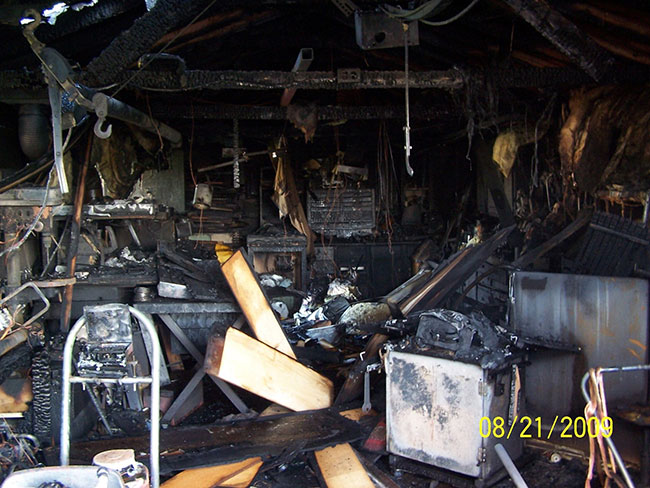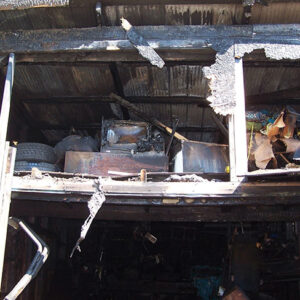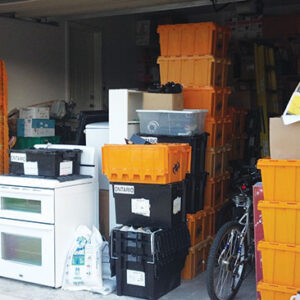
Features
Back to Basics: Garage fires, Part 3
April 27, 2023
By Mark van der Feyst
 Photo 1: Heavily weighted truss supports will weaken and collapse under high heat
Photos by Mark van der Feyst
Photo 1: Heavily weighted truss supports will weaken and collapse under high heat
Photos by Mark van der Feyst In our continued look at garage fires and the hidden dangers that are found within and outside them, we are progressing to examine the hidden dangers that lay within the garage. This is a concerning area because we are not able to see or know ahead of time what is inside the garage. We will see dangers on the outside on arrival as part of our size-up, but the inside is a complete unknown.
When we study hazardous materials operations response, we look to the placard to identify what we are dealing with inside a container. When the commodity is a mixed load, the “Dangerous” placard is used to identify it. This is the same approach that we must take with garage fires. They are a mixed fuel load of “who knows what” and if we could placard garages, they would all have the “Dangerous” placard on the outside.
For most homes across our country, the garage is used for more than just vehicles. The garage has become a storage unit, a den, a converted office, a workshop, a workout area, or a mixture of the uses mentioned. No matter what size of home we are responding to, the garage seems to be a multi-purpose or multi-use area for the homeowner.
The biggest hazard in a garage will be the vehicle. This is due to the large fire load that it is – a heavy laden hydro-carbon fuel box containing multiple fluid systems, including gasoline. Along with the hydro-carbon fuel, we are also finding electrical fuel sources as well. This may include charging systems being used to recharge a hybrid or electrical vehicle.
We can’t forget that the vehicle will also contain items inside in the occupant compartments as well as the truck or pick-up truck bed or in the storage areas of other types of vehicles. These items are also unknown and can be extremely flammable/combustible and dangerous to our efforts.
With vehicles inside the garage, we must be mindful of vehicle storage systems that may be found within the garage. These systems allow for multiple vehicles to be stored in a vertical fashion using hydraulic/electric lifts. A double car garage can accommodate four vehicles stacked two high in each bay.
The area above the garage on the inside is also used for storage by many homeowners. This open area will vary in width and height based upon the style of the garage, but it will be packed with stored items. The weight limit of these open areas are limited and it seems that many homeowners ignore these limits and cram a ton of weight above there. For all they know, it is designed for storage when in reality it is not. Lightweight truss construction is what makes up these structural supports and they do not provide that much strength on the bottom chord.
In Photo 1, you will see the fall out of weakened truss supports under a high heat source and weighed down above by heavy objects: the trusses fail, dumping the contents on the garage floor. In Photo 2, you will see another garage with heavy storage above the garage floor. Just think of the collapse potential that exists, and when it does, who it is trapping and injuring underneath it.
We have considered the exposed storage areas, but what about the ones that we cannot see? Consider false ceilings in a garage with an attic hatch opening somewhere allowing access into the attic area of the garage. This area is going to be a storage facility containing the same issues as with the exposed ones. The difference is that we cannot see this until it is to late.
The contents stored inside a garage can be anything. From various cleaning supplies, fuels, ammunition, chemicals, paints, solvents, Mig/Tig welders, oxy-acetylene welders, arc welders, etc. The types of content are limitless. In Photo 3, you will see an example of this but with the entire garage being used as a storage unit. Notice the high piling of some of the storage bins which coincidently go all the way to the back of the garage.
We must also take into consideration utilities that will be present. Some homeowners will have gas fed heating systems, or electrical or propane fed heating systems. Others may have wood fired heating systems inside. Besides the fuel source being the hazard, the units themselves hanging from the ceiling are HVAC units that do weigh considerably.
Some homeowners will convert their garage or purpose build it to have a recessed pit for automobile working purposes – a giant hole in the middle of the garage! There will also be entanglement hazards found within the garage with Christmas lights being stored, wires, decorations and so on. The garage door opener is also a hazard in that if not controlled or locked out, it may close trapping firefighters inside.
What has been detailed here is generic approach to what may be found inside a garage. As you respond to calls within your district, take a look at what’s inside peoples garages when they have the doors open and you will be surprised at what you will see. Be prepared to expect the worst with a garage fire based upon what may be inside of it.
Mark van der Feyst has been in the fire service since 1999 and is currently a firefighter with the FGFD. Mark is an international instructor teaching in Canada, U.S. FDIC and India. He is the lead author of Fire Engineering’s Residential Fire Rescue & Tactical Firefighter books. Contact him at Mark@FireStarTraining.com.
Print this page
Advertisement
- Floodwater disaster mitigation seeks to make B.C. communities safer
- Coquitlam opens new fire training centre

